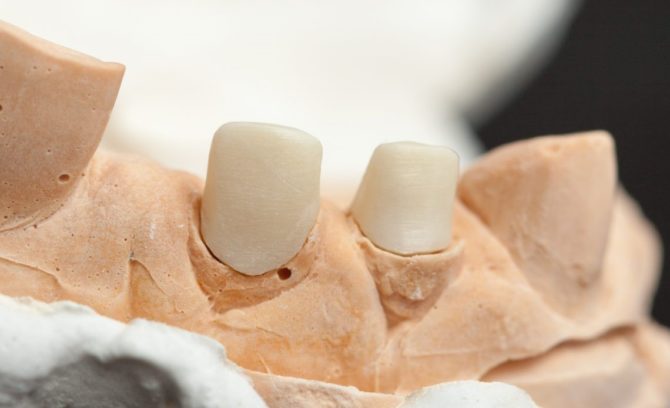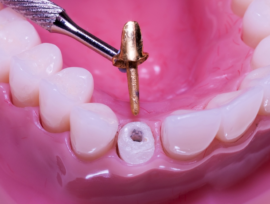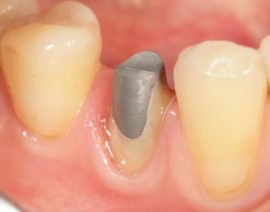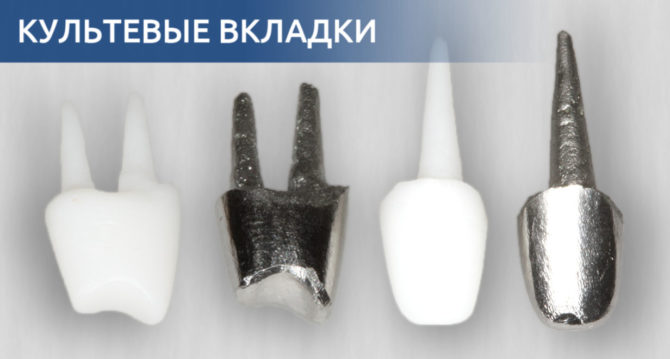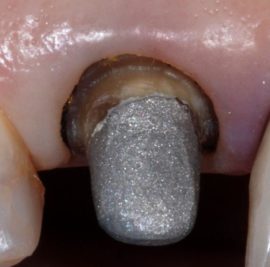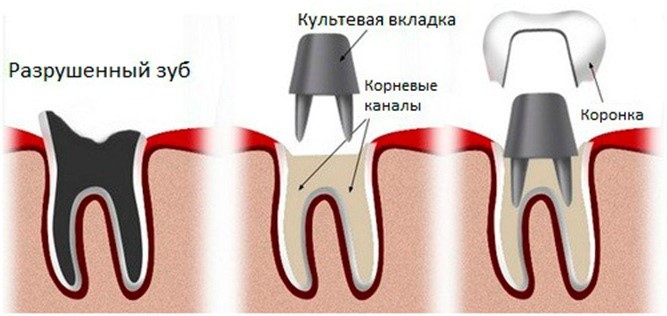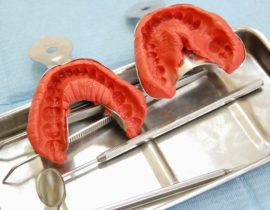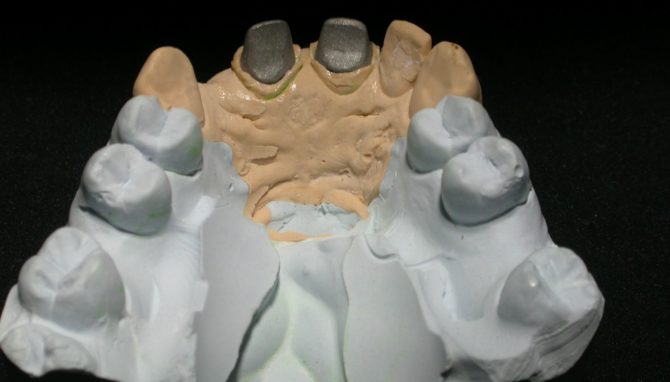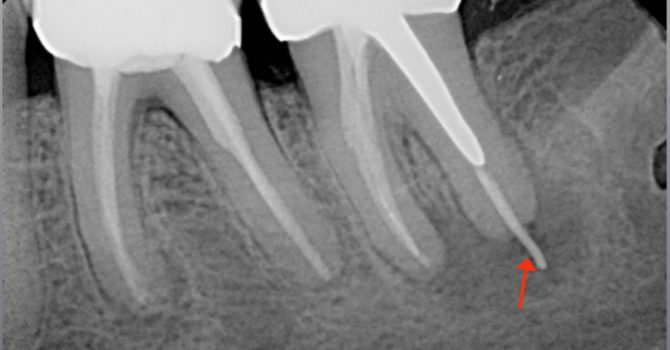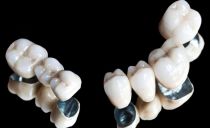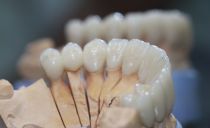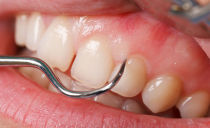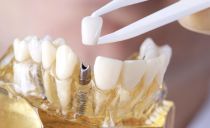Stump tab for teeth under the crown: what is it, types, cost
Used in dentistry crown tabs are small orthopedic constructions that help restore and strengthen teeth. They allow you to restore even badly damaged teeth, are installed in their root part after endodontic treatment and can be made from various dental materials. An example of a cult tab under the crown is shown in the photo.
Content
Build, features and benefits
The tab consists of a stump and processes that are fixed in the channels. Makes her dental technician on an individual print. The design is a small and inexpensive, but very necessary product for high-quality treatment and prosthetics.
Construction Functions:
- Strengthening root canals and hard tissues.
- Creating a stump for fixing crowns or dentures.
- Correct distribution of chewing pressure.
- Restoration of the physiological functions of the tooth.
Indications
Tab tooth restoration is carried out after endodontic treatment root canal systems, that is, after the elimination of pulpitis or periodontitis. With these diseases, tooth tissue is destroyed, often the crown is completely destroyed. To restore the tooth, a crown prosthesis is necessary, and the crown must be installed on the tooth stump. When the natural stump is preserved, the installation of the crown is carried out immediately. In the absence of such, it is necessary to create a support, so first make a stump tab.
Indications for the manufacture of the structure:
- significant tooth decay;
- lack of crown;
- one or two thin walls of the tooth;
- the need to manufacture a bridge with a support;
- large and wide tooth canal.
Contraindications
Installing the stump tab under the crown is not recommended in the following cases:
- poor-quality root canal treatment;
- root damage;
- chronic inflammatory processes in periodontal tissues;
- tooth mobility;
- periodontitis, periodontal disease;
- allergic reaction to the design.
Advantages and disadvantages
In the field of dentistry, stump inserts are very important designs. With their help, you can save teeth, from which only the root remains. The disadvantages include a higher cost compared to standard pins and the fact that the manufacturing process requires several visits to the doctor.
Products have many advantages:
- the ability to restore even badly damaged teeth;
- fixation with dental cements prevents the development of caries and other dental diseases;
- root strengthening occurs;
- chewing pressure is evenly distributed;
- reliable fixing is provided;
- high strength;
- the crown can be replaced without removing the tab;
- a wide selection of materials for manufacturing;
- long service life;
- low cost.
Types of Stump Tabs
The tabs that are used for prosthetics are of several types: single-root, two-root and three-root.The choice of one or another is determined by the number of roots in the tooth.
According to the manufacturing method, the products are cast and folding. Folding consists of several parts that are installed in the tooth. Cast stump tab is made by casting and has a monoblock structure.
There are also different types of tabs, depending on the material of manufacture:
-
Metal tab under the crown. This is the simplest and most inexpensive type of product. It is made of alloys of tin and chromium, cobalt and chromium, as well as alloys of precious metals. The advantages include high strength, reliability, efficiency, low cost. The disadvantage of the product is an unaesthetic appearance, so this tab is often placed on the side teeth. Such structures are covered with metal or cermet crowns. Gold items are the most aesthetic and hypoallergenic.
- Zirconia Stump Tab. It is made of a special material - zirconium dioxide - and has special properties. The product combines high strength and perfect aesthetics. For non-metal ceramics, it is recommended to install only this type of structure so that the material does not show through. Zirconia is expensive and is used primarily for restoration of the front teeth.
- Ceramic design rarely used. The tab has good aesthetics, but is not strong enough and can break under considerable chewing pressure.
Comparison of different orthopedic designs
Patients who have to restore teeth are faced with the choice of orthopedic design. Doctors prosthetists can offer several treatment options with which you can restore your teeth and their functions. But what is better to install the crown on the tooth - on the tab or on the pin - the patient decides.
| Crown | Tab | Pin |
|---|---|---|
| It is used to restore the anatomical structure of the tooth. | It is used to strengthen the root and create a stump. | It is used to strengthen the root |
| Made from different materials | Made from different materials | There are metal and fiberglass |
| Made in a few visits | Made in a few visits | Installed in one visit |
| High price | average cost | Very low cost |
We can conclude that each design has its own indications, contraindications, pluses, minuses and features. What is better to establish should be determined based on the individual clinical situation in the oral cavity. In the presence of severely damaged teeth, the installation of pins may be ineffective, it is better to give preference to stump tabs. Each patient will need a crown installation, since without it, treatment with reinforcing structures would be inferior.
Set Stump Tab
Dental treatment of the patient consists of the following stages:
- Initial consultation.
- Examination of the oral cavity.
- The choice of treatment method.
- Training.
- Clinical and laboratory stages of orthopedic construction.
- Adaptation period.
Before making the design, the dentist treats the tooth and its canals. To do this, all destroyed tissues are removed, the root canals are cleaned, treated with endodontic instruments and antiseptics, and high-quality filling is performed. Mandatory control of treatment using x-rays.
A few days after the filling material hardens, the orthopedic surgeon prepares the channels for the tab. To do this, the channels are processed with special tools 2/3 of the length, in the process, excess filling material is removed.
After preparing the channel under the tab, the impression is taken.The dentist takes a double impression to produce an accurate design. First, the impression material is introduced into the root with the help of a channel filler, after it hardens, the material is placed on the jaw area and the impression is taken.
The finished impression should reflect all the features of the tooth and the root canal. Only in this form, the design is transferred to the laboratory, where the dental technician performs the manufacture of the tab. In clinics, the product is manufactured from 5 to 7 working days, in private clinics this process is faster.
The doctor processes the finished insert with antiseptic solutions and tries on in the mouth. A correctly made construction should fit snugly against the walls of the canal, close the entrance to the tooth, not interfere with the bite, and have a smooth surface without pores.
If the tab meets the necessary requirements, the doctor carries out its installation. First, the channel is treated with adhesive cement, and then the tab is fixed to it.
Setting a tab is not the final step in orthopedic treatment. To restore the anatomy of the tooth, the functions of chewing, speech and aesthetics, it is necessary to make a crown. To do this, a second impression is taken, according to which the dental technician makes the construction. The finished crown is checked and fixed on the dental material. With significant defects in the dentition, not a crown is installed, but a bridge.
Lab tab manufacturing
The design is made in two ways: by the dental technician himself or using computer technology. The first method is classical, the second arose with the development of technology and is the most innovative.
Dental technicians make products from all kinds of materials, but most often from metal. A technician casts a model on a print, models a wax tab, and then casts and makes a metal structure. Ceramic products go through the baking phase in the oven. The finished insert is polished and polished with special tools.
Zirconium inlay is made using CAD / CAM technology. Preparing the root, taking a cast and obtaining its digital model. Information is transferred from the computer to the milling machine, on which the product is made of zirconium oxide. If necessary, ceramic coated is applied to it.
The stump tab on the front tooth should be made of light materials. When using metal, dark transmission through the crown is possible, during which the patient will experience discomfort. In the lateral sections of the jaw can be used any kind of product. For successful treatment, it is necessary to select the optimal orthopedic design in advance.
How much does a tab for a crown cost?
Before treatment, you should familiarize yourself with its cost. How much this or that tab per tooth costs depends on several factors:
- View tabs.
- Manufacturing material.
- The number of roots.
- Manufacturing method.
- The equipment of the dental laboratory.
- Experience and qualifications of a specialist.
- Prestige dental clinic.
In Moscow, a single-root metal tab in a tooth costs about two thousand rubles, a two-root metal about three thousand rubles. Ceramic products have a cost of more than ten thousand rubles, and the zirconium construction will cost more than fifteen thousand rubles. Gold designs also have a high cost.
The life of the tabs for the teeth under the crown
The tab is a very strong design, it is almost impossible to break a metal product. It owes such properties to the material and the manufacturing method. Usually, specialists give a one-year guarantee on the design, but in reality the life of the insert for the teeth under the crown exceeds 10 years.
If the crown is erased or broken, it can be replaced with a new one without removing the tab, which was prosthetized in advance.
Possible complications
If the tab is improperly manufactured, a variety of complications arise. The design on the tooth becomes mobile, there is an incorrect distribution of chewing pressure, there is pressure on the soft tissue of the gums. The crown and tab may break and injure the root of the tooth. But most often, complications arise with poor-quality root canal filling.
If the canal is not completely filled or incompletely cleaned, chronic inflammation develops, which is manifested by exacerbations. In a tooth with orthopedic designs, acute pain occurs, which can be eliminated by removing the prosthesis. Therefore, for dental treatment, you should choose only a competent and qualified doctor who will give a guarantee for the work and perform it in a quality manner.
Dental care after prosthetics
The design will serve for a long time and without the risk of complications, if you follow the doctor's recommendations and adhere to such rules:
- Perform good oral hygiene daily. You should brush your teeth in the morning after breakfast and in the evening before going to bed.
- For hygienic care, use products specially selected by the doctor that are suitable for enamel and effectively cope with plaque.
- Daily use floss (floss) to clean the interdental spaces, since an ordinary brush cannot clean out the remnants of food from them. Especially carefully you need to use the floss in the presence of orthopedic structures in the mouth. To clear the gap, you need to insert the floss into it and stretch it towards the lips.
- Once every six months, you need to visit the dentist for a routine examination.
- Twice a year, professional dental hygiene should be carried out.
- After eating, you can rinse your mouth with water or use a rinse aid.
- If you experience any complications, you should consult a doctor, in no case should you self-medicate.
The stump tab is needed to treat badly damaged teeth. The product has excellent properties: strength, efficiency, long life, low cost. It allows you to save teeth that cannot be cured otherwise., and restores their functions.

